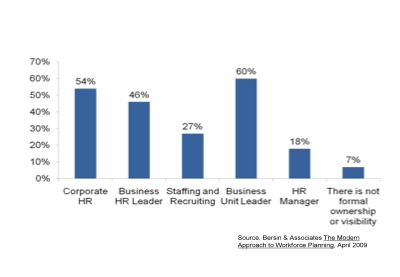 While close to half of organizations consider workforce planning an integral part of their overall staffing and recruiting, only 27% of workforce planning processes are conducted by recruiting and staffing departments. See the chart, showing ownership of workforce planning.
While close to half of organizations consider workforce planning an integral part of their overall staffing and recruiting, only 27% of workforce planning processes are conducted by recruiting and staffing departments. See the chart, showing ownership of workforce planning.
That’s data from the Bersin & Associates’ Workforce Planning survey (which a lot of people from ERE took earlier this year). Sixty-seven organizations, mainly in the U.S. and Canada, responded. Bersin partnered with the Newman Group.
The majority of workforce planning processes are owned by individual business leaders, and thus disjointed from recruiting and even HR. At many organizations, such as T-Mobile, talent acquisition directors expressed a strong demand for workforce planning, but the responsibility to lead this program lay with the benefactors of the data, the business unit leaders.
Workforce planning needs to be an integral part of the overall staffing and recruiting organization. In this capacity, talent acquisition should not only create interest around the topic; it should help drive the process.
In order to gain a seat at the table, talent acquisition needs to share in the level of ownership and accountability for workforce planning.
In strategic workforce planning processes (something I’m writing about in the June Journal of Corporate Recruiting Leadership), 43% of workforce planning efforts are conducted by recruiting and staffing. As a result, 64% are able to better plan recruiting and staffing needs. Companies that implement consistent workforce planning processes throughout their entire organization rely heavily on their talent acquisition departments.
They take a different approach and involve recruiting: 53% of these organizations indicated that workforce planning is conducted by recruiting and staffing. One key driver for workforce planning is to link recruitment, development, and training decisions to organizational goals. Without involvement and support from talent acquisition departments, organizations will not achieve this goal.